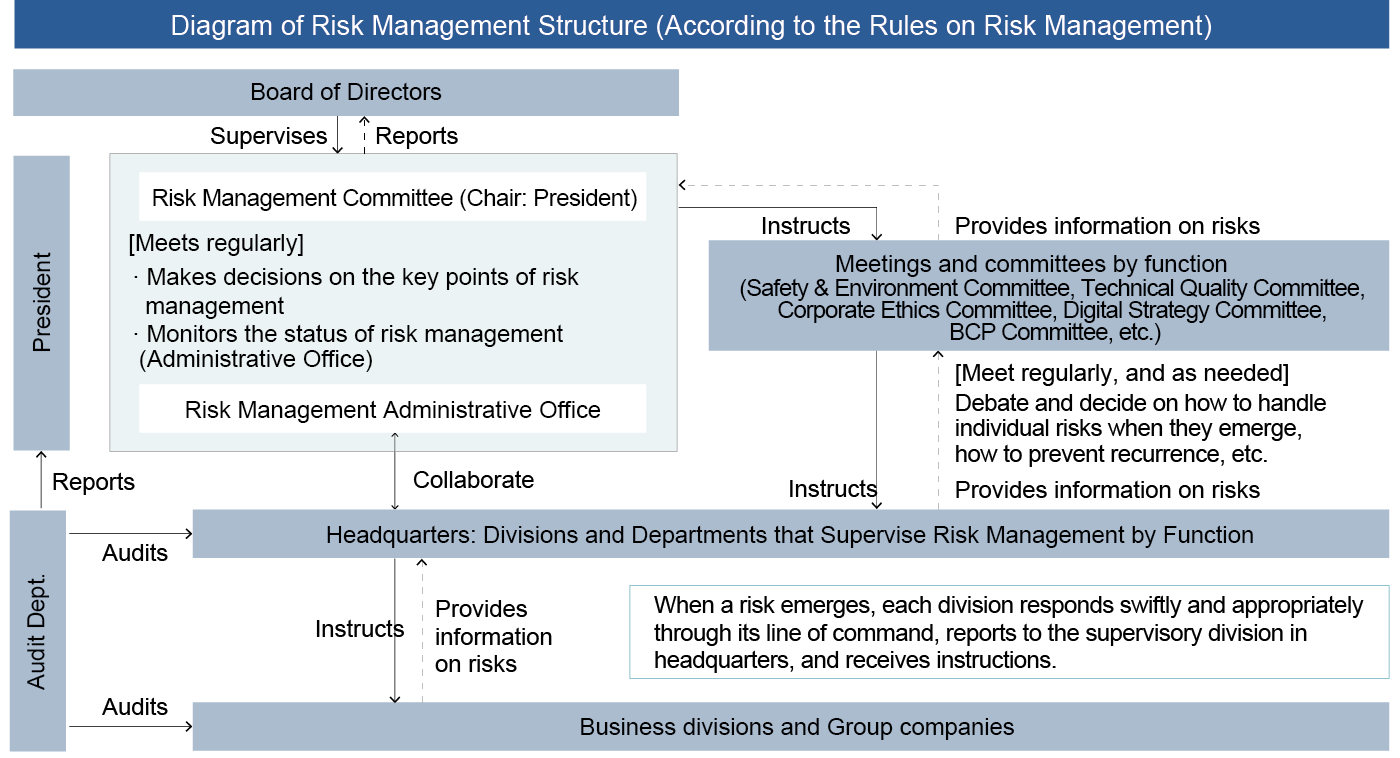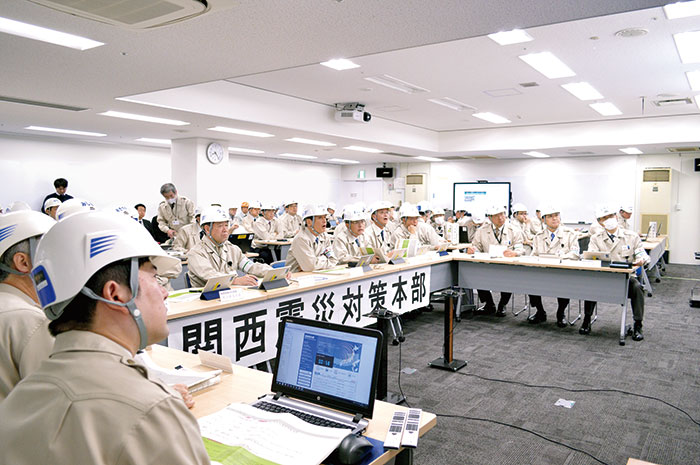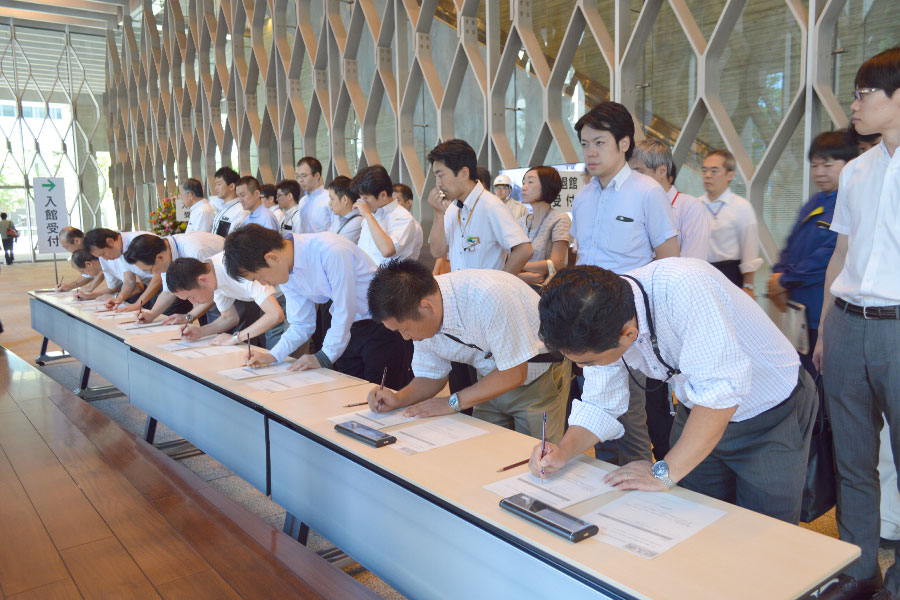The Shimizu Group works to ensure business continuity and stable growth by mitigating risks and minimizing potential losses. We achieve this by identifying risks relevant to our business activities and managing them appropriately.
Taking a PDCA Cycle Approach to Risk Management
Risk Management Structure
Each fiscal year, the Risk Management Committee (Chair: CEO) makes decisions on key items of risk management for the entire company and each division incorporates these decisions into its business plans – some of these risks are listed below. Furthermore, in order to ensure appropriate risk management, we implement a PDCA cycle by monitoring risks by function at the head office, business division, and group company levels, providing timely guidance and oversight for corrective actions as necessary, and leveraging these insights to respond to emerging risks. The Board of Directors provides direct oversight by having the Risk Management Committee report directly to them, and by monitoring and evaluating the implementation and effectiveness of the Code of Corporate Ethics and Conduct and Risk Management Rules.
ESG-related issues are also included among the risks monitored by the Board of Directors and the Risk Management Committee. These include legal and regulatory violation risks and environmental and safety risks. The Code of Corporate Ethics and Conduct, which is also overseen by the Board of Directors and the Risk Management Committee, covers a comprehensive range of corruption issues including bribery and accounting fraud.
Risk Management Structure (According to risk management regulations)

Information Security
Information Security Policy
Shimizu strives to satisfy its clients through quality construction and relevant services and aims to contribute to the sustainable development of the 21st century society. In order to fulfill these goals, Shimizu recognizes the importance of utilizing information as efficiently and effectively as possible in order to leverage the company’s full range of available resources. In its use of such information, Shimizu, including its Group companies, are committed to maintaining an appropriate standard for information security.
Information Security Guideline
- Develop an information security management system that complies with international standards, and continuously maintain and improve upon this system.
- For all information under our oversight related to business activities, and all related systems that use this information, we will clarify the scope and reasons for protection in order to develop solutions for appropriate information management.
- In order to maintain and continuously improve upon information security, we will appoint a committee at the group-company level to consistently promote and manage information security throughout the entire company.
- We will work to expand and deepen the understanding and knowledge of information security amongst our employees and company affiliates through educational and informative initiatives.
- By conducting routine audits and assessments regarding information security, we will identify and confirm new and emerging risks, as well as assess external environmental changes, in order to continuously manage these risks.
Management and Protection of Personal Information
In 2005, Shimizu drafted its Privacy Policy and based on this, continues to protect personal information.
Privacy Policy (Guidelines on protection of personal information)
Information Security Initiatives
Based on the established Information Security Guideline and the accompanying information security management structure, Shimizu has taken a range of initiatives to improve security levels. This has included security enhancement around the company’s IT infrastructure, provision of educational contents regarding information security, and raising awareness about policy/guideline revisions.
Shimizu aims to raise awareness of information security amongst each and every one of its employees through initiatives such as the targeted threat prevention activities. Furthermore, Shimizu continuously works with specialty contractors whom we collaborate with on construction projects to strengthen information security management.
Business Continuity Plan (BCP)
Basic Principles
In recent years, changes in the natural environment such as climate change and global warming have precipitated natural disasters that cannot be responded to with existing practices. At Shimizu, we have done many things to counteract disasters in the past, have formulated a business continuity plan (BCP) to prepare for the occurrence of disasters of a level which we are unable to respond with the existing network of countermeasures. The plan is revised as needed.
In cases of natural disasters, our mission is to secure the safety of citizens residing in areas affected by disaster and to preserve the foundation for living and the foundation of society. In our BCP, we focus on promptly preserving our workplace and facilities, supporting the recovery and restoration of the affected areas and supporting our customers to restart their businesses as quickly as possible.
In order to act promptly under such circumstances, our individual employees must understand their roles and act independently and responsibly. Additionally, we must prepare to be able adapt to new situations and quickly reform our corporate structure. In accordance to the points above, our BCP policy is established as below:
BCP Basic Policy
- Prioritize ensuring and confirming the safety of our workers and their family
- Strive to preserve our facilities and job sites where construction is in progress
- Assist in the restoration of customer facilities (properties built by Shimizu)
- Contribute to ensuring the living foundation for society and community
- Create a structure that allows workers that are involved in preservation activities to act independently and responsibly
Identifying Risks and Estimating Potential Damages
Emergencies caused by devastating disasters such as natural disasters having a high probability of widespread impact on Shimizu’s business activities including suspension or cessation of headquarter functions (large earthquakes, pandemics, volcanic eruptions, widespread flooding, super typhoons, or other disasters and accidents) are designated as targeted risks.
Conducting BCP Drills to Prepare for an Earthquake Directly Beneath the Greater Tokyo Area
As the types of natural disasters become more varied and increase in duration and intensity, we must consider responses to risks that were not foreseen in conventional business continuity planning (BCP). Shimizu also revised its BCP to respond to such new risks, and conducted a company-wide BCP emergency drill on March 11, 2019 based on the scenario of an earthquake directly beneath the Greater Tokyo Area. The scenario of the drill was a magnitude 8 earthquake with a seismic intensity of 7 occurring at 2:00 am under the northern part of Tokyo Bay. In the scenario, the area surrounding the head office suffered catastrophic damage and headquarter functions had become inoperable.

It was determined that establishing an emergency response headquarters at the head office would be impossible in such conditions, so an alternate headquarters was temporarily established at the Kansai Branch in Chuo-ku, Osaka, and directed company-wide response activities until head office functions were restored. As was the case in previous drills, the safety of employees was confirmed and information on damage to Shimizu facilities, job sites, and customer facilities was collected as part of the drill response. A new part of the drill in which the Kansai Branch took over the head office functions of wage payment and processing of customer payments was also conducted until it was handed back to a functioning Tokyo office three days later. We will continue these drills in the future to strengthen our ability to respond in an emergency.
Promoting Disaster Prevention Activities Together with the Community
At the request of Chuo-ku authorities, Shimizu’s main office building has been designated as a regional disaster center and will provide space to temporarily shelter people who cannot return home.
We have established a system to manage the center. Shimizu is helping to build a disaster prevention system based on mutual assistance, in cooperation with Chuo-ku and other companies.
Serving as a regional disaster center is at the core of our contribution to the community.

Addressing Business Risks
Risks associated primarily with changes in the external environment
| Overview of main risks | Main measures/initiatives |
|---|---|
| 1.Risk of shrinking construction market | |
| If private capital investment were to decrease due to recessions in Japan or overseas, or if public investment were to be reduced for the purpose of fiscal consolidation, it could affect future orders. | The Board of Directors follows up on the outlook of orders in the construction business and the potential projects volume monthly and provides instructions on necessary measures at meetings of the Executive Officers Council and business division managers. Looking ahead to 2030, in the long-term vision SHIMZ VISION 2030, we are promoting the business according to the Mid-Term Business Plan <2024-2026> with the aim of changing the profit structure by expanding our non-construction businesses. |
| 2.Risk of fluctuation in construction material prices and labor costs | |
| If construction material prices, labor costs or other such expenses were to increase significantly more than anticipated after contracts are signed and it were to be difficult to reflect that increase in the contract price, it could lead to an increase in construction costs and worsen the profit and loss situation. | In principle, when signing construction contracts with clients, we are making an effort to discuss adoption of provisions related to changing the contract amount based on fluctuations in labor wages and construction prices (i.e., a sliding scale clause). |
| 3.Credit risk related to business partners | |
| If a business partner such as a client, a subcontractor, or a joint construction partner were to run into credit problems, it could result in failure to recover funds, construction delays, or other such circumstances. | In addition to thorough credit screening and continuous monitoring of our business partners, we are striving to sign contracts that include protection of the Group’s credit. |
| 4.Risk related to overseas business | |
| As we are engaged in business overseas, if there were to be significant changes in the political or economic conditions, exchange rates, tax systems, legal regulations, or other circumstances in emerging countries or if acts of terror, war, or riots were to occur, material prices and labor costs were to rise substantially, or a strain in the labor supply were to arise, it could affect progress on construction or construction profit and loss. | When developing our business overseas, we narrow down the list of regions and countries based on business opportunities and country risks and take the necessary measures. Main initiatives
|
| 5.Risk related to investment and development business | |
| If the business environment in the investment development field were to change significantly, such as a slump in the real estate market due to economic slowdown or fluctuations in the financial markets, it could affect our business performance. | We establish annual investment plans to operate within a range of risk that is commensurate with our corporate strength, and in individual investments, we invest in a calculated manner, including exit strategies (investment recovery plans), based on investment criteria. The Board of Directors regularly follows up on the progress of the Investment and Development Business, investment balance, business portfolio, and market value, taking measures as necessary. |
| 6.Long-term business risk | |
| In long-term businesses such as the PFI business and the renewable energy business, if the business environment were to change significantly, such as an increase in prices, personnel expenses, and interest rates or a business partner running into credit problems, it could affect our business performance. | The Board of Directors regularly follows up on the progress of the PFI business, renewable energy business, and others, taking measures as necessary. |
| 7.Risk of fluctuation in price of investment securities | |
| If the value of investment securities were to drop significantly, it could affect our business performance. | Every year, we review the significance of each securities holdings based on a comprehensive consideration of the associated costs and risks, business advantages, and other economic reasons. The Board of Directors verifies the necessity of the security holdings and, in principle, sells those that have diminished in significance. |
| 8.Risk of fluctuation in interest rates/exchange rates | |
| If interest rates were to rise sharply or exchange rates were to fluctuate significantly, it could affect our business performance. | We engage in risk management according to our Financial Market Fluctuation Risk Management Rules.
Main initiatives
|
| 9.Risk of natural disaster/infectious disease | |
| If a natural disaster such as an earthquake, tsunami, storm or flood damage, or a pandemic were to occur, it could result in direct damage to the Group’s assets or employees and affect our business activities. If the disaster were to be large in scale, the changes in the business environment such as order fluctuation, soaring construction material prices, and decreased electric power/energy supply capacity could affect our business performance. |
We established a BCP Committee to continuously review our BCP, determine training plans, and follow up on the status of implementation.
Main initiatives
|
| 10.Cybersecurity risk | |
| If we were to fall victim to a cyberattack such as a targeted e-mail attack or malware attack leading to viral infection or unauthorized access, it could affect our business activities or valuation. | We have established a Digital Strategy Committee to discuss matters related to information security, and we take the necessary measures. Main initiatives
|
| 11.Risk related to creation, revision, or repeal of laws | |
| If new laws and regulations were to be enacted or existing laws were to be revised or repealed due to changes in society or the times, it could affect our business performance or valuation. | To properly respond to establishment of new laws or revision/repeal of existing ones that affect our business activities, we have prepared our own rules and regulations, provided notice through various meeting bodies, company intranet, and other means, and are implementing internal education and training (including e-learning). |
| 12.Risk of long-term climate change | |
| If regulations or carbon taxes were to be adopted for new building construction in the transition to a decarbonized society or if average temperatures were to increase or climate disasters were to become more frequent or intense as physical effects of climate change, it could affect our business activities. | In October 2019, we declared our support for the recommendations of the Task Force on Climate-related Financial Disclosures (TCFD). We have analyzed and disclosed risks and opportunities related to climate change and are implementing measures to address climate change.
Main initiatives
|
| 13.Risk related to retirement benefit obligations | |
| If it becomes necessary to change the actuarial assumptions of retirement benefit obligations due to a decline in the market value of pension assets or the discount rate, it could affect our business performance. | We have established a Pension Asset Management Committee. It deliberates on asset management performance and conducts financial result simulations for review and revision of the basic policy on pension asset management and policy asset mix while appropriately monitoring the status of management by the contracted management company and reporting to the Board of Directors annually. |
Risks arising primarily inside organization from industry characteristics
| Overview of main risks | Main measures/initiatives |
|---|---|
| 1.Risk of serious accidents or contractual non-conformities | |
| If a serious accident, defect, or injury related to engineering or quality were to occur in the design or construction stage, resulting in a large repair cost or construction delay, or a serious contractual non-conformity, it could affect our business performance or valuation. | Our business approach of “safety first,” “respect for human life,” “customer first,” and “quality assurance” is shared within the company, and we work to raise awareness of safety and quality. Main initiatives
|
| 2.Risk of leakage of personal or confidential information | |
| If personal or confidential information acquired in our business activities were to be leaked, it could affect our business performance and valuation. | By establishing a Privacy Policy, preparing personal information protection regulations, and appointing a Corporate Personal Information Protection Administrator, we are properly managing personal information and implementing various measures to address information security risks.
Main initiatives
|
| 3.Risk of legal violations | |
| The construction industry, which is the main business field of the Group, is subject to various legal regulations, including the Construction Business Act, the Building Standards Act, the Real Estate Brokerage Act, the National Land Use Planning Act, the City Planning Act, the Antimonopoly Act, and various laws related to safety, the environment, labor, and harassment. If an illegal act were to take place within the Group, it could affect our business performance or valuation. | We put into practice the Analects and the Abacus (Ethics and Economics), and the entire Group works to reinforce ethical awareness and ensure thorough compliance.
Main initiatives
|
| 4.Risk of medium- to long-term worker shortage | |
| The skilled workers who are leaders in the construction industry are aging, and if there is not a generational change via an increase in new workers by the time that baby boomers retire in large numbers, it could compromise production, thereby affecting our business activities and performance. | Through public-private partnerships, we are working to secure and train workers, improve benefits, and increase the attractiveness of the construction industry.
Main initiatives
|



